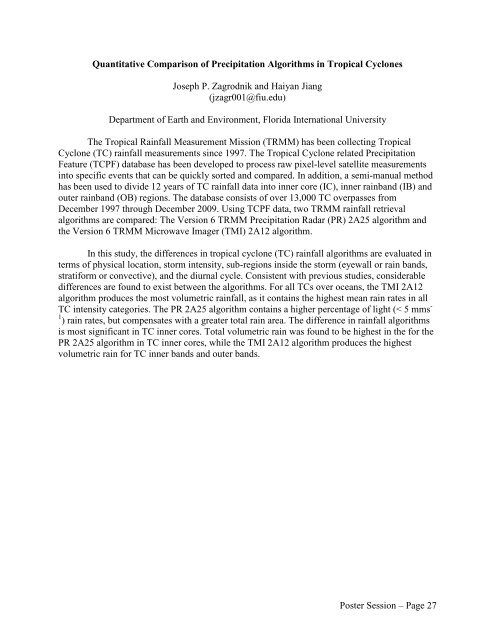65th IHC Booklet/Program (pdf - 4.9MB) - Office of the Federal ...
65th IHC Booklet/Program (pdf - 4.9MB) - Office of the Federal ...
65th IHC Booklet/Program (pdf - 4.9MB) - Office of the Federal ...
Create successful ePaper yourself
Turn your PDF publications into a flip-book with our unique Google optimized e-Paper software.
Quantitative Comparison <strong>of</strong> Precipitation Algorithms in Tropical Cyclones<br />
Joseph P. Zagrodnik and Haiyan Jiang<br />
(jzagr001@fiu.edu)<br />
Department <strong>of</strong> Earth and Environment, Florida International University<br />
The Tropical Rainfall Measurement Mission (TRMM) has been collecting Tropical<br />
Cyclone (TC) rainfall measurements since 1997. The Tropical Cyclone related Precipitation<br />
Feature (TCPF) database has been developed to process raw pixel-level satellite measurements<br />
into specific events that can be quickly sorted and compared. In addition, a semi-manual method<br />
has been used to divide 12 years <strong>of</strong> TC rainfall data into inner core (IC), inner rainband (IB) and<br />
outer rainband (OB) regions. The database consists <strong>of</strong> over 13,000 TC overpasses from<br />
December 1997 through December 2009. Using TCPF data, two TRMM rainfall retrieval<br />
algorithms are compared: The Version 6 TRMM Precipitation Radar (PR) 2A25 algorithm and<br />
<strong>the</strong> Version 6 TRMM Microwave Imager (TMI) 2A12 algorithm.<br />
In this study, <strong>the</strong> differences in tropical cyclone (TC) rainfall algorithms are evaluated in<br />
terms <strong>of</strong> physical location, storm intensity, sub-regions inside <strong>the</strong> storm (eyewall or rain bands,<br />
stratiform or convective), and <strong>the</strong> diurnal cycle. Consistent with previous studies, considerable<br />
differences are found to exist between <strong>the</strong> algorithms. For all TCs over oceans, <strong>the</strong> TMI 2A12<br />
algorithm produces <strong>the</strong> most volumetric rainfall, as it contains <strong>the</strong> highest mean rain rates in all<br />
TC intensity categories. The PR 2A25 algorithm contains a higher percentage <strong>of</strong> light (< 5 mms -<br />
1 ) rain rates, but compensates with a greater total rain area. The difference in rainfall algorithms<br />
is most significant in TC inner cores. Total volumetric rain was found to be highest in <strong>the</strong> for <strong>the</strong><br />
PR 2A25 algorithm in TC inner cores, while <strong>the</strong> TMI 2A12 algorithm produces <strong>the</strong> highest<br />
volumetric rain for TC inner bands and outer bands.<br />
Poster Session – Page 27
















